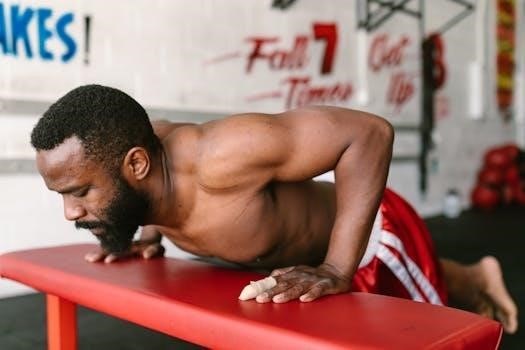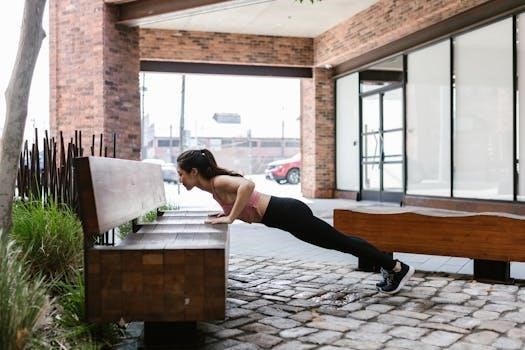
30-Minute Bodyweight Workout PDF⁚ A Comprehensive Guide
Embark on a transformative fitness journey with our comprehensive guide to 30-minute bodyweight workouts!
This resource empowers you to achieve peak physical condition using only your body weight, anytime, anywhere, and without any equipment.
Bodyweight training is a highly effective method that utilizes your own weight to provide resistance, enabling you to build strength, endurance, and flexibility. It is a versatile and accessible form of exercise, perfect for individuals of all fitness levels, from beginners to advanced athletes.
Unlike gym-based workouts that rely on specialized equipment, bodyweight exercises can be performed virtually anywhere, making them ideal for home workouts, travel, or outdoor fitness sessions.
This type of training focuses on compound movements, engaging multiple muscle groups simultaneously. This approach not only saves time but also enhances coordination, balance, and overall functional fitness. Common bodyweight exercises include push-ups, squats, lunges, planks, and burpees, each offering unique benefits.
Bodyweight training allows for easy modification, adapting exercises to suit your current fitness level. By adjusting the intensity, repetitions, or sets, you can progressively challenge yourself and continue to see results. With bodyweight training, you can achieve a full-body workout that is both effective and convenient.
Benefits of 30-Minute Bodyweight Workouts

Incorporating 30-minute bodyweight workouts into your routine offers a multitude of benefits for your physical and mental well-being. These workouts are incredibly time-efficient, making them perfect for busy individuals who struggle to find time for longer gym sessions.
Bodyweight exercises enhance strength and endurance by engaging multiple muscle groups simultaneously. This leads to improved muscle tone, increased metabolism, and enhanced overall fitness.
These workouts can significantly boost cardiovascular health, improving heart function and reducing the risk of chronic diseases. The dynamic nature of bodyweight exercises elevates your heart rate, providing an effective cardio workout without the need for equipment.
Bodyweight training improves flexibility, balance, and coordination. Exercises like lunges and planks enhance core stability, which is essential for everyday movements and injury prevention.
Regular bodyweight workouts can lead to weight loss by burning calories and increasing muscle mass. The convenience and accessibility of these workouts make it easier to stay consistent, leading to sustainable results.
Furthermore, bodyweight training can improve mental well-being by reducing stress, boosting mood, and increasing self-esteem.
Key Bodyweight Exercises for a Full-Body Workout
To achieve a comprehensive full-body workout using just your body weight, it’s essential to incorporate a variety of exercises that target all major muscle groups.
Squats are a fundamental exercise for lower body strength, working the quads, hamstrings, and glutes. Variations like jump squats can add an extra cardio element.
Push-ups are excellent for building upper body strength, targeting the chest, shoulders, and triceps. Modifications such as incline or decline push-ups can adjust the difficulty.
Lunges effectively work the legs and glutes, improving balance and coordination. Alternating lunges or lateral lunges can provide a varied challenge.
Plank is a core-strengthening exercise that engages the abdominal muscles, lower back, and shoulders. Variations like side planks can further challenge your core.
Burpees are a full-body exercise that combines squats, push-ups, and jumps, providing a high-intensity cardio and strength workout.
Glute bridges target the glutes and hamstrings, improving hip extension and core stability. Single-leg glute bridges can increase the intensity.
Dips (using a chair or bench) target the triceps and chest, providing an effective upper body exercise.
By incorporating these key exercises, you can create a well-rounded bodyweight workout that builds strength, endurance, and overall fitness.
Sample 30-Minute Bodyweight Workout Routine (PDF)
This sample 30-minute bodyweight workout routine is designed to provide a full-body workout that can be performed anywhere, without the need for equipment. The routine is structured into three main parts⁚ a warm-up, a workout circuit, and a cool-down.
The warm-up prepares your muscles for exercise and reduces the risk of injury. The workout circuit consists of a series of exercises performed in a sequence, with minimal rest between exercises. This approach maximizes calorie burn and improves cardiovascular fitness.
The cool-down helps your body gradually return to its resting state, reducing muscle soreness and promoting recovery. The workout circuit incorporates exercises that target all major muscle groups, including squats, push-ups, lunges, planks, and burpees.
The number of repetitions and sets can be adjusted based on your fitness level. For beginners, it is recommended to start with fewer repetitions and sets, gradually increasing the intensity as you get stronger.
Remember to maintain proper form throughout the workout to prevent injuries. This routine can be easily modified to suit different fitness levels and preferences.
A downloadable PDF version of this routine will be provided, allowing you to easily access and follow the workout at your convenience.
Warm-up (5 minutes)
Before diving into the main workout, a proper warm-up is crucial for preparing your body and preventing injuries. This 5-minute warm-up routine is designed to increase blood flow, improve muscle flexibility, and activate key muscle groups. Start with light cardio, such as jogging in place or jumping jacks for about two minutes, to elevate your heart rate.
Next, incorporate dynamic stretching exercises that mimic the movements you’ll be performing during the workout. Arm circles, both forward and backward, help to loosen up your shoulder joints. Leg swings, both forward and sideways, improve hip mobility. Torso twists gently warm up your core muscles.
Finally, perform some bodyweight movements like squats and lunges, but at a slower pace and with a reduced range of motion compared to the workout. This primes your muscles for the upcoming exercises.
Remember to listen to your body and avoid pushing yourself too hard during the warm-up. The goal is to prepare your muscles, not to fatigue them. By following this warm-up routine, you’ll be setting yourself up for a more effective and safer workout.
Workout Circuit (20 minutes)
The core of your 30-minute bodyweight routine is the workout circuit. This 20-minute circuit is designed to target all major muscle groups, providing a full-body workout that builds strength, improves endurance, and burns calories. The circuit consists of a series of exercises performed back-to-back with minimal rest in between.

A typical circuit might include exercises like squats, push-ups, lunges, planks, and burpees. Each exercise should be performed for a specific duration, such as 30-40 seconds, followed by a short rest period of 15-20 seconds. After completing one round of all exercises, take a longer rest of 1-2 minutes before starting the next round.
Aim to complete 3-4 rounds of the circuit within the 20-minute timeframe. The specific exercises and their duration can be adjusted based on your fitness level and goals. Remember to maintain proper form throughout each exercise to maximize its effectiveness and prevent injuries.
Focus on engaging your core muscles during each movement for added stability and strength. As you get fitter, you can increase the duration of each exercise, reduce the rest periods, or add more challenging variations of the exercises.
Cool-down (5 minutes)
The cool-down phase is a crucial, yet often overlooked, part of any workout routine. This 5-minute segment is designed to gradually bring your heart rate and breathing back to normal after the intense workout circuit. It also helps to reduce muscle soreness and improve flexibility.
The cool-down typically involves light cardio exercises, such as walking or gentle cycling, followed by static stretching. Static stretching involves holding each stretch for 20-30 seconds, focusing on major muscle groups like hamstrings, quadriceps, calves, chest, and shoulders.
It’s essential to breathe deeply and relax into each stretch, avoiding any bouncing or jerky movements. The cool-down allows your muscles to recover and reduces the risk of injury. It also promotes relaxation and reduces stress.
Consider incorporating yoga-inspired stretches to enhance flexibility and promote mindfulness. A proper cool-down not only aids in physical recovery but also contributes to mental well-being, making it an integral part of your 30-minute bodyweight workout routine.
Don’t skip this important step – your body will thank you!
Modifications for Different Fitness Levels
Adapting a workout to suit individual fitness levels is crucial for safety and effectiveness. Our 30-minute bodyweight workout is designed to be accessible to everyone, regardless of their current fitness ability. This section outlines modifications to ensure both beginners and advanced individuals can benefit from the routine.
For beginners, modifications focus on reducing the intensity and complexity of exercises. This might involve performing fewer repetitions, taking longer rest periods, or opting for easier variations of movements, such as knee push-ups instead of standard push-ups. The goal is to build a solid foundation of strength and endurance without risking injury.
Advanced individuals, on the other hand, can increase the challenge by adding repetitions, reducing rest times, or incorporating more complex variations of exercises. Examples include performing plyometric exercises like jump squats or adding resistance with items like resistance bands. The key is to push your limits safely and effectively.
Listen to your body and adjust the workout accordingly. Proper form is always more important than the number of repetitions. By tailoring the workout to your specific needs, you can maximize results and minimize the risk of injury.
Beginner Modifications
Starting a bodyweight workout routine can be daunting for beginners. Therefore, adapting exercises to a more manageable level is key to building confidence and preventing injuries. These modifications focus on reducing intensity while maintaining proper form.
For push-ups, perform them on your knees instead of your toes to reduce the load. Squats can be modified by reducing the depth of the squat, focusing on maintaining good posture rather than going as low as possible. Lunges can be shortened, taking smaller steps to reduce stress on the knees.
Plank exercises can be modified by holding for shorter durations, such as 15-20 seconds, gradually increasing the time as strength improves. Jumping jacks can be replaced with step-out jacks, eliminating the jump for a lower-impact option.
Remember to prioritize proper form over the number of repetitions. It’s better to do fewer repetitions with correct form than to struggle with incorrect form, which can lead to injuries. Listen to your body and rest when needed. Gradually increase the intensity and duration of the exercises as you get stronger.
These beginner modifications will help you build a solid foundation for a successful bodyweight workout routine.
Advanced Modifications
For those seeking a greater challenge, advanced modifications can elevate your bodyweight workout, pushing your strength and endurance to new heights. These variations increase the intensity and complexity of the exercises.
Elevate your push-ups by performing them with your feet elevated on a bench or chair, increasing the load on your upper body. Instead of regular squats, try pistol squats, which involve balancing on one leg while squatting, requiring significant strength and stability. Lunge variations include jumping lunges, adding a plyometric element that boosts cardiovascular fitness and lower body power.
Plank exercises can be advanced by incorporating variations like plank jacks or plank with shoulder taps, challenging your core stability further. For a more intense core workout, try performing V-ups or dragon flags.
Incorporate plyometric exercises like burpees or box jumps to enhance your cardiovascular fitness and explosive power. Consider adding resistance by wearing a weighted vest or using resistance bands to further challenge your muscles.
Remember to maintain proper form even when performing these advanced modifications. Focus on controlled movements and listen to your body to avoid injuries. These advanced modifications will help you push your limits and achieve even greater fitness results.
Tips for Maximizing Your Bodyweight Workout
To truly unlock the potential of your 30-minute bodyweight workout, consider these invaluable tips that will amplify your results and keep you motivated. Prioritize progressive overload by gradually increasing the difficulty of your exercises over time. This could involve increasing repetitions, sets, or holding times, or trying more challenging variations of the exercises.
Focus on mind-muscle connection, concentrating on the muscles you are working during each exercise. This will help you engage the correct muscles and improve your form. Incorporate different training techniques such as supersets or drop sets to further challenge your muscles.
Ensure you are getting adequate nutrition to support your workouts. Consume a balanced diet with sufficient protein to aid muscle recovery and growth. Stay hydrated by drinking plenty of water throughout the day, especially before, during, and after your workout.
Listen to your body and allow for adequate rest and recovery. Avoid overtraining, which can lead to injuries and burnout. Get enough sleep to allow your body to repair and rebuild muscle tissue.
Stay consistent with your workouts to see the best results. Make it a habit to exercise regularly, even when you don’t feel like it. Find an exercise buddy or join a fitness group to stay motivated and accountable.
Importance of Proper Form
Maintaining proper form during your 30-minute bodyweight workout is paramount for safety and effectiveness. Correct form ensures that you are targeting the intended muscles, maximizing the benefits of each exercise, and minimizing the risk of injuries.
Before starting any exercise, take the time to understand the correct technique. Watch videos, read instructions, or consult with a fitness professional to learn the proper form. Start with easier variations of the exercises to master the form before progressing to more challenging versions.
Pay close attention to your body alignment during each exercise. Keep your core engaged, your back straight, and your joints aligned. Avoid rounding your back, hyperextending your knees, or letting your hips sag. Use a mirror to check your form or ask a friend to watch you and provide feedback.
Focus on controlled movements rather than rushing through the exercises. Slow and deliberate movements allow you to maintain better form and engage your muscles more effectively. If you find that you are struggling to maintain proper form, reduce the number of repetitions or sets.
If you experience any pain during an exercise, stop immediately. Pain is a sign that something is not right. Consult with a healthcare professional to determine the cause of the pain and get appropriate treatment.
Your Path to Fitness with Bodyweight Training
Staying Consistent and Tracking Progress
Consistency is key to achieving your fitness goals with bodyweight workouts. Aim to incorporate your 30-minute routine into your schedule several times a week. Treat your workouts like important appointments, and make them a non-negotiable part of your day. Find a time that works best for you and stick to it.
To stay motivated, track your progress. Keep a workout journal or use a fitness app to record the exercises you do, the number of repetitions, and the sets you complete. Note how you feel after each workout.
Tracking your progress allows you to see how far you’ve come and motivates you to keep going. It also helps you identify areas where you need to improve. Over time, you’ll be able to increase the number of repetitions, sets, or the difficulty of the exercises.
Set realistic goals for yourself. Don’t expect to see results overnight. It takes time and effort to build strength and endurance. Focus on making small, consistent improvements, and celebrate your successes along the way.
Reward yourself for reaching your goals. This will help you stay motivated and make exercise more enjoyable.
